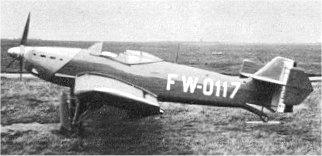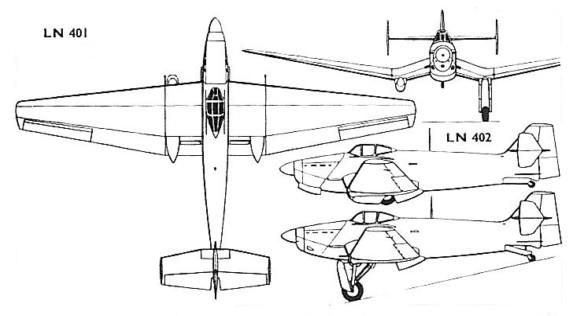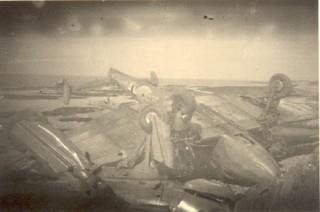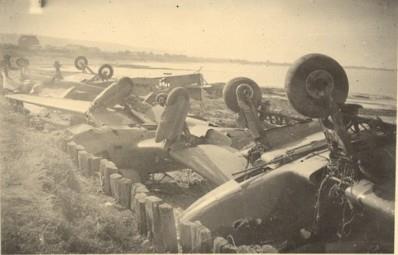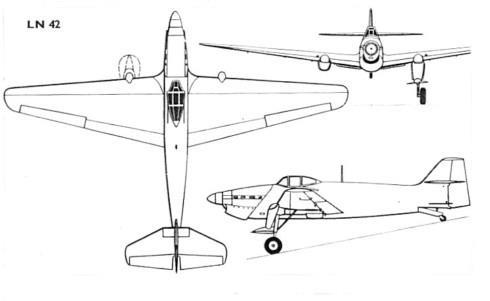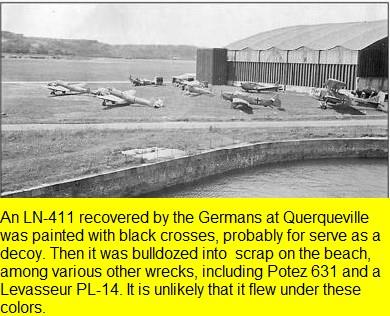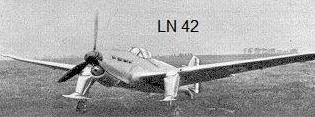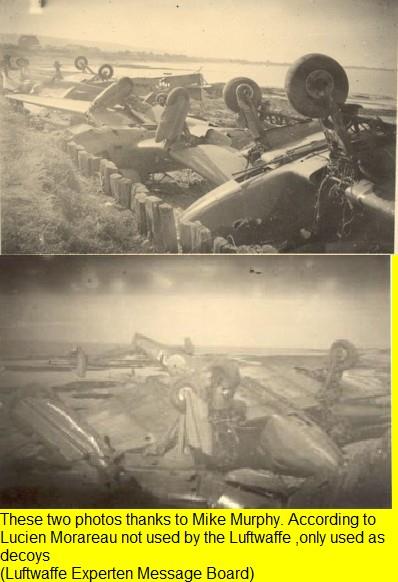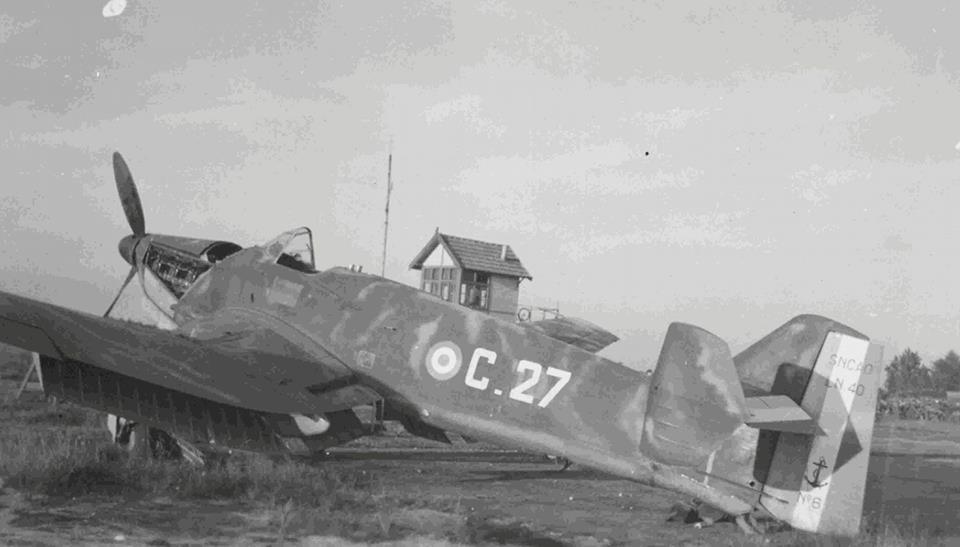| Type |
Single seat dive bomber |
| Engine |
1 Hispano-Suiza 12Xcrs |
| Dimensions |
Length 9,75 m, height 3,5 m, span 14 ,0 m , wing area 24,75 m2 , |
| Weights |
Empty 2243 kg, loaded 2835 kg , max. take off weight |
| Performance |
Max.. speed 380 km/h at 4000 m , cruising speed 299 km/h , range 1200 km, endurance , service ceiling 9500 m , climb |
| Armament |
1 × Hispano-Suiza HS.404 20 mm (0.787 in) cannon and 2 × 7.5 mm (0.295 in) Darne machine guns
Bombs: 1 × 225 kg (496 lb) or 165 kg (364 lb) bomb, or 10 × 10 kg (22 lb) or 15 kg (33 lb) bombs |
| Type |
Werk.Nr |
Registration |
History |
|
|
|
|
From experience gained with the Ni-140 prototypes, Pillon's team initiated in 1936 the study of a single-seat shipboard divebomber with a semi-retractable undercarriage, commencing prototype construction at the Issy Les-Moulineaux plant in the following year. Designated LN 40 No. l, the prototype commenced flight trials at Villacoublay in June 1938 with the SNCAO chief test pilot, Pierre Nadot, at the controls. Like its predecessor. the LN 40 was an inverted gull wing monoplane, this arrangement having been chosen so that the manually operated wing folding mechanism was situated at a convenient height. with a monocoque fuselage inspired by that of the experimental Ni-161 single-seat fighter. All fuel was housed in the wing centre section, the lower half of the rudder was divided vertically so that it opened in two segments at right angles to serve as dive brakes, a crutch beneath the fuselage swung forward to ensure that the bomb cleared the airscrew disc when released, and the main undercarriage members retracted rearwards, the wheels remaining semi-exposed when retracted. Flight trials revealed the need for additional vertical tail surface area, and auxiliary endplate fins were added to the tailplane for the official trials which began in September 1938. Further trials were undertaken at the naval test centre at Saint Raphael where, in November, 15 dives and 10 arrested landings were made.
A further six LN 40s had been ordered in 1937, before prototype trials had begun, these being completed to production standards as LN 401s. An additional 36 examples were ordered for the French Navy in February 1939, and deliveries had begun by mid-1939, by which time the Armée de I'Air, which had been impressed by the effect of dive-bombers in Spain, had ordered 40 examples of a land-based version, the LN 411, which differed from the shipboard model in having the wing folding and arrester hook eliminated. In the event, by October 1939 the Armée-de I'Air had concluded that the performance of the LN 411 was too low for successful operation in its intended role, and it was agreed that the French Navy should take delivery of 39 of the 40 aircraft of this type ordered, the remaining example being retained by the Ministére de I'Air for conversion as the prototype LN 42.
The LN 401 was powered by a Hispano-Suiza 12Xcrs 12-cylinder liquid-cooled Vee engine rated at 690 hp at 4000 m with which it attained maximum speeds of 320 km/h at sea level and 380 km/h at
4000 m. Maximum cruising speed was 340 km/h and range was 1 200 km. Empty and loaded weights were 2 243 kg and 2 835 kg respectively, and overall dimensions included a span of 14 m, a length of 9,75 m, a height of 3,5 m, and a wing area of 24,75 m2.
Built-in armament comprised one engine-mounted 20-mm Hispano-Suiza cannon and two wing-mounted 7,5-mm Darne machine guns, and the ventral crutch could carry one 225-kg BEA 1938 or one 150-kg Type 12 bomb.
The first 16 LN 401s were undergoing acceptance trials in November 1939 and were subsequently issued to Escadrilles AB2 and AB4. As France's sole aircraft carrier, the Béarn, was engaged in the task of transporting to France warplanes purchased in the USA, the LN 401s were never involved in shipboard operations, being shore-based throughout their career. Escadrille AB4 converted from the LN 401 to the LN 411 in April 1940, its LN 401s being distributed among Escadrille AB2, the conversion unit at Lanvéoc-Poulmic, and the war reserve at Cherbourg. By May 10, 1940, AB2 and AB4 each had its full complement of 12 aircraft, the former being based at Berck and the latter, still completing its operational training, at Cherbourg-Querqueville. AB2 had undertaken its first sorties when the LN 411s of AB4 joined it at Berck on May 17th. Two days later, 10 aircraft were lost to flak during an attack by 20 aircraft from both escadrilles on the crossroads at Berlaimont, and the 10 that survived the sortie to reach Berck were all so badly damaged that on the following day only three aircraft could be mustered for an attack on the Origny Bridge over the Oise, one of these being lost. On May 21st another aircraft was shot down to leave the two escadrilles with one airworthy machine.
Orders for the LN 401 and 411 placed prior to May 29, 1940 totalled 152 aircraft, although only a small proportion of these was completed. Repair of the least damaged aircraft and the delivery of a few new machines gave the two escadrilles a combined strength of 10 LN 401s and 411s on May 22nd, but operations had to be suspended as most of the ground personnel had been captured in the Boulogne area. Both escadrilles arrived at Hyeres on June 4th, flying some reconnaissance missions along the Italian coastline and providing some air cover for French Navy units shelling Genoa on June 14th. Nine days later the two escadrilles were transferred to Bone, and on August Ist they were redesignated 2AB and 4AB respectively, subsequently converting to Martin 167s. All surviving LN 401s and 411s were disassembled for storage, and during 1941 the Chateauroux plant of the SNCASO began the assembly of 24 LN 401s and 411 s from components recovered, with German-. authorisation, from the occupied zone, completing this task in March 1942. The aircraft were flown to Hyeres but were not issued to any Vichy unit, and as 12 LN 401 s and 411s were allegedly seized by the Luftwaffe when German forces entered the unoccupied zone in November 1942, it may be assumed that the remainder were among those in storage at Bizerte-Karouba and destroyed by Allied bombing attack.
One aircraft flown early in 1940 with an 860 hp Hispano-Suiza 12Y31 engine received the designation LN 402, but the previously-mentioned prototype LN 42 was still incomplete at the Issy Les-Moulineaux plant in June 1940. The LN 42 retained the fuselage of the LN 401-411 but had a 1,100 hp Hispano-Suiza 12Y51 engine and a completely redesigned wing of 13 m span with a gross area of 21 m2. The prototype was transported to Istres where taxying and one or two short hops were reportedly made before the aircraft was hidden at a farm at Flayosque, in the Draguignan area, alongside the prototype of the SO 30N commercial transport. After the liberation, the LN 42 was transported to Toussus-le-Noble where it flew on August 24, 1945. In the summer of 1946 it was fitted with a reversible-pitch Escher-Wyss airscrew with which it flew on October 28, 1946, but the aircraft was by now obsolescent and was eventually scrapped.
